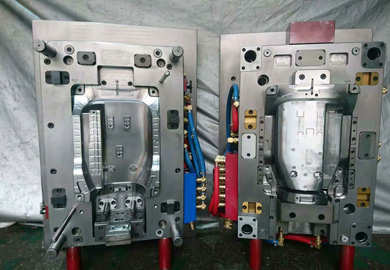
After the mold is assembled for trial or normal production, the mold must be preheated and the mold temperature should be uniform. The preheating temperature of the die-casting mold of aluminum-magnesium alloy is recommended to be 250-320 °C, and it is best to use a mold temperature machine to preheat; the mold is preheated to 300 °C, and its impact toughness is improved rapidly, but when the mold temperature is lower than 200 °C, The impact toughness of the material is greatly reduced, and the brittleness is increased; the thermal conductivity of a well-preheated mold is nearly 20% higher than that of a mold without good preheating; the greater the difference between the casting temperature of the die casting mould and the mold surface temperature (preheating temperature), the greater the thermal stress, the easier it is to cause thermal fatigue and cracking.
The pouring temperature should be reasonable and not too high. Otherwise, the pouring temperature is too high, although the fluidity is better, but the casting takes a long time to condense, and it is easy to produce shrinkage holes and pores, which is easy to reduce the surface hardness of the mold, and the mold sticks and cracks occur. Adjust the clamping force of the die-casting machine so that the mold is evenly stressed.
Correctly select (or adjust) the filling speed and filling pressure. Too high filling speed (injection speed) will increase the probability of damage to the surface of the cavity due to erosion and die sticking. Too low filling speed, although beneficial to gas discharge, will reduce the mechanical properties of the casting and deteriorate the surface quality. In the same way, the increase of the filling pressure will also increase the filling speed of the nozzle. In short, to adjust a moderate value.
During die casting, the mold release agent should be sprayed on the surface of the cavity in contact with the metal solution. Its main function is to prevent the metal solution from adhering to the surface of the cavity and to ensure the separation of the casting and the mold wall, so as to prolong the life of the mold.
Release agents include water and oil. In recent years, powder and granular release agents have also been developed. Requirement: The release agent must not adversely affect the surface quality of the casting, no odor and smoke should occur, and no residue should be left behind.
The concentration of the release agent should be appropriate, and it should be stirred frequently, and it must not be allowed to settle, otherwise the die-casting mold cavity will cause thermal fatigue cracking due to extreme cold.
The amount of spraying should be small, the spraying should be uniform, and the film formed should be thin. Spraying too much and too thick will cause defects such as loose casting, slag inclusion, blistering, and pores.
If the spraying effect of water release agent is not good, oil release agent or powder release agent should be selected. But use it in a vacuum. Castings have fast demoulding, high productivity, good quality, and less thermal stress generated by the mold, which is beneficial to prolong the service life of the mold.
To ensure the composition of the aluminum alloy, the melting of the aluminum alloy and the heat preservation tank must be separated. In central smelting, the gas content should be strictly controlled, and it is absolutely necessary to avoid directly adding waste products and return materials to the holding furnace, otherwise it will pollute the molten metal, which will not only seriously reduce the quality of castings, but also easily cause mold sticking and corrosion of molds.
The content of Fe in the aluminum alloy solution should be controlled between 0.7% and 1.3%. If it is less than 0.7%, it is easy to cause sticking. If it is more than 1.3%, it will form metal compound hard spots and cause erosion.
1. Clean and clean the mold in time to remove cavity residue and flash;
2. Replace or repair damaged parts;
3. Regularly carry out stress relief treatment on the mold:
The first stress relief treatment is when the initial production mold is used for about 2000 to 5000 mold times;
The second stress relief treatment is when using 10,000 to 20,000 mold times;
The rest of the stress relief treatment interval is the same as above, and the maximum cannot exceed 15000 times.
4. After the die-casting mold has been used for a period of time, the hardness of the surface of the inspection mold has decreased. When the mold sticking phenomenon occurs, the surface of the mold should be ground and smooth, and a soft nitriding treatment should be performed. The thickness of the nitriding layer is 0.08 ~ 0.12mm, or soft nitrogen chemical + oxidation composite treatment, it will effectively improve the service life of the mold.






 Call us on:
Call us on:  Email Us:
Email Us:  Shengan Building A, Hengzeng Road Chang'an Town Dongguan City,
Shengan Building A, Hengzeng Road Chang'an Town Dongguan City,